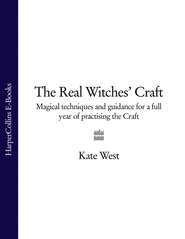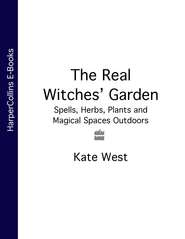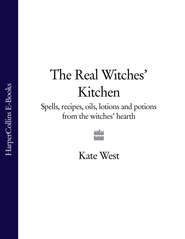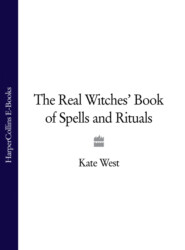По всем вопросам обращайтесь на: info@litportal.ru
(©) 2003-2024.
✖
The Real Witches’ Handbook: The Definitive Handbook of Advanced Magical Techniques
Автор
Год написания книги
2018
Настройки чтения
Размер шрифта
Высота строк
Поля
Witchcraft has been described as ‘a thinking person’s religion’ and this is a serious book about the Craft. It is written for all those who are serious about studying and practising, whether on their own or in preparation for joining a Coven. Some of the content may seem a little dry to those who are keen to get on with the actual practice of Magic, but persevere, for all the parts are relevant to the understanding of the religion, ritual and Magic of Witchcraft. Think of the first couple of chapters as an introduction before the practical work of the rest of the book.
Use this as a workbook and make notes to record your own thoughts and feelings about what you are reading and in relation to the work you do in the Craft. In this way it will become not just a book to read, but also the foundation for your own Book of Shadows, the volume which forms the basis of every Witch’s practice.
So for all the ‘young in Craft’ who would take charge of their future, for those inexperienced in spiritual variety, for those whose search for their own path has been exploratory, I offer an introduction to practising the oft misunderstood and misconstrued belief system of the Witch.
Blessed Be
Kate
ONE WITCHCRAFT:THE MYTHS (#ulink_afee5dbf-67b4-5e6f-b5b3-645870ef393d)
Witches are normal everyday people, the kind you pass on the street without giving them a second glance or thought. They are men and women from all age groups, who have all kinds of jobs and normal family lives. They are just like everyone else; in fact they could be just anyone else. But you wouldn’t think that if you were to look at the myths that have grown up about them.
The word ‘Witch’ conjures up many images. A Witch was a woman (for it usually was a woman) who lived on the edge of the village and who would heal the sick if treated well, but curdle your milk and spoil your crops if you upset her – or even curse your cattle, or your children, so that they would sicken and die. In return for her immortal soul she would have made a pact with the Devil for unnatural powers. And the Devil himself would accompany her in the form of a familiar, who in turn would feed off her flesh. Such Witches were supposed to gather together, flying by broomstick, so that they could join in orgies and meet the Devil in person.
A Witch might also be the old hag living alone in a tumbledown cottage in the forest, feared by all. In fairy tales, she would lure innocent children inside to eat them and drink their blood. Or the Witch might be a wicked fairy, not invited to the feast, who would curse the family as a result.
More recently the Witch’s image has been influenced by books, music, films and TV. From Bell, Book and Candle to The Craft, Bewitched to The X-Files and Buffy the Vampire Slayer, Witches are now frequently portrayed as younger, attractive women. They are shown as having control over others. Using ancient powers they perform strange rituals (with lots of modern special effects) and conjure up spirits who do their bidding. They are seen to make people fall in love, to gain revenge on their enemies and even to conjure up uncompleted homework! In books they are often linked with Satanists, whose extensive powers enable them to live in improbably wonderful houses. And somehow along the way, Witches have been linked to the imagery of Goth and other forms of music, with their vampiric fashions, archaic black clothing, heavy make-up and jewellery.
Other things linked to Witchcraft include broomsticks, cauldrons and black cats, hooked noses, warts, pointed hats and billowing cloaks (black of course). The Full Moon and Halloween are thought to be especially ‘Witchy’ times.
Now, within these stories and images there are elements of truth, but they are hidden by exaggerations, fabrications and even political intrigue. To understand how these images arose, it is necessary to know a little about the background and history of the Craft.
Before Christianity became established (anything from 1,600 to 800 years ago in the various parts of Europe), there were other belief systems. Often called nature religions, these were based around the phases of the Moon, the cycles of the seasons, the land and the animals which lived on it. Different groups held different beliefs and worshipped different Gods and Goddesses, without conflict as far as we know. Roman Gods and Goddesses had shrines or temples alongside those of the native population. At first Christianity was just another belief system and its churches also co-existed peacefully. However, as it became linked with the Crown and the Government it became more powerful and in order to maintain control it sought to eradicate those earlier beliefs.
The Gods of the nature religions now came to be called devils or demons and their followers were accused of laying curses and practising foul Magic which ruined crops, sickened cattle and caused children to fall ill or to die. They were even accused of child murder and sacrifice. Stories were invented or altered to discourage people, especially children, from seeking to learn more. Special agents were appointed to hunt out the ‘evil doers’. Special laws were introduced to cover their ‘crimes’. Incentives, in terms of the land and money of those convicted, were provided to encourage people to report those neighbours and fellow villagers who might be involved in such ‘demonic’ activities.
There is nothing unusual in this – it is a process that has been, and still continues to be, repeated whenever the people of one faith seek to take control over the land, property and power of those of another. In the same way that after the Reformation one part of the Church sought to outlaw and eradicate another, so the Arabs and Jews are still fighting over Israel to this day.
But to return to the takeover of the nature religions, as a result of the Church’s actions many innocent people were arrested, many were tortured and many were executed, some lawfully, others by the mob. Those who did wish to continue to follow the old religions did so secretly. They handed down their knowledge and beliefs by word of mouth and held their celebrations away from prying eyes. From the outside it appeared that Witchcraft had become a thing of the past, so much so that by the 1950s, it was no longer seen as a threat in Britain. The final remnants of the Witchcraft Act, first instituted in 1542, were finally repealed and Witches started, cautiously, to become more open once again.
The last 50 years have seen a great improvement in the way that people think about Witches and the Craft and media coverage is more favourable. Today, as a known Witch, I am less likely to have my windows broken or my tyres slashed than even 10 years ago, but there are still many misconceptions and I would like to address some of them here:
Witches are in league with the Devil and the same as Satanists.
Witches do not believe in, let alone worship, a devil. They do not believe in an evil being whose purpose is to balance out the good God. Witches believe in personal responsibility – we are each responsible for whatever we do, whether good or bad, and can blame no outside force (or devil) for those actions which we subsequently regret.
Nor is the practice of divination anything to do with conjuring up spirits who can see into the future. Divination is a way of accessing our own skills to see what is coming in our own and other people’s lives.
Witches practise Black Magic.
Magic itself is neither good nor bad, white nor black, it is a neutral force in the same way as electricity is. If Magic is used in a positive and beneficial way it is often called ‘white’; when used negatively it is often referred to as ‘black’. However, most Witches try to adhere to the main ‘rule’ of the Craft, the Wiccan Rede, which states: ‘An’ it harm none, do what thou will.’ Whilst there are undoubtedly a few Witches who do work Magic for selfish reasons or to the detriment of others, the vast majority of Magical workings are for the benefit of others.
Witches sacrifice animals.
Witches have a great respect for nature and for the rights of others. They do not believe that people have rights over animals or each other and do not make blood sacrifices. What they do sacrifice is time and energy. They may also make offerings of wine, oils, gemstones or items they have created themselves.
Witchcraft is all about sex and nudity.
Witchcraft is one of the ancient fertility religions. However, it is common to confuse fertility and sex. Fertility is not just about having babies, it is about inspiration, having new ideas. A fertile relationship is one where both partners assist one another to develop their individual potential to the full, where growth is encouraged, not restricted. This may or may not include having a family. A fertile business is one with new products, markets and customers.
It is also common to mistake the term ‘nature religion’ for ‘naturist’. Naturists are those who prefer to remove their clothes as much of the time as possible, as they find this totally acceptable and a more comfortable way of being. There is nothing in the Craft which demands nudity, indeed one of the key tenets is that no one should ever be forced to do anything they are uncomfortable with. Some Witches do indeed work their rituals naked, or ‘skyclad’ as it is termed, while others work in robes or in special but everyday clothing. This is because changing what you wear marks the step between daily life and ritual working. Some Witches may also be naturists, but this tends to be more likely in the warmer parts of the globe!
Witchcraft is a ‘pick and mix’ religion.
Certainly the Craft overall has no set rituals or formulae and no defining text. As a Witch you can refer to the God or Goddess by different names at different times and you are expected to make your own judgements as to what is right and wrong on a day-to-day basis. There are no ‘authorities’ to tell you what to do, say and think.
There are many who feel that this all means Witchcraft cannot be a true religion – in other words, there are not enough rules! However, the Wiccan Rede, ‘An’ it harm none, do what thou will’, whilst being a positive statement, is nevertheless a lot to live up to.
There is no proof that Witchcraft has any historical basis prior to the last 50 years.
It is true that there is little recorded history prior to the 1950s. Given the background of the persecution of Witches, not to mention the fact that writing was a skill available only to the privileged, this is hardly surprising. However, a few documents have survived in private hands and there are of course the Church’s own records, which seem to point to the continuation of the Craft. After all, why bother to persecute something which you do not believe exists? The absence of a long written ‘pedigree’ does not invalidate a belief system. Whether today’s Witchcraft has been handed down as an intact religion, whether it is a renewed version of an older belief system or whether it has almost totally reinvented itself does not actually matter. What does matter is whether it is valid today for those who would practise it.
Witches have a hooked nose and warts.
As I once said in an interview, ‘Well, I wouldn’t be much of a Witch if I couldn’t get rid of those!’ Spreading the idea that Witches are ugly is simply another way of discouraging people from becoming interested in something that is not understood.
Witches are glamorous.
This is a more modern misconception. What you have to remember is that the people who make fictional TV programmes and films are rarely doing so in order to portray facts, they are in the business to attract an audience and make money – obvious when you think of it. However, there are still lots of people who believe, without thinking, that Witches all look like Buffy and Sabrina, etc., and that it is the Witchcraft which makes them look good. This is only accurate in that practising the Craft will make you feel better about yourself and encourage you to have respect for your mind, body and spirit. Additionally, because for most of us the imperfections we perceive are false or exaggerated, the self-honesty that the Craft requires will result in a more positive self-image.
Witches wear black.
Witches wear whatever they wish. They are not instantly recognizable by their clothes or the way they look. However, when working in groups, especially outdoors at night, Witches will often wear dark or black clothing, for two very practical reasons. First, if you are disturbed in your workings it is far easier for you to disappear if you blend into your surroundings. Witchcraft is not a spectator activity and no one wants to gather an audience of dog walkers or people returning from the pub who fancy a bit of light entertainment. Secondly, dark colours show the dirt less. Witches may be tending a fire or sitting on the ground or simply brush up against a tree – and light clothing generates extra laundry!
Witches wear a long cloak and pointed hat.
Many Witches do have a long cloak for use outdoors, as it covers clothing and keeps the weather out. It is especially useful if you wear robes. Also, a long dark cloak with a hood enables you to pull up the hood, step into the trees and become invisible to anyone but the most keen observer. The pointed hat, however, is not something many Witches will own unless they have a taste for fancy-dress parties. It is said by some to represent the cone of power which is often raised when working Magic. But as the cone of power is something on the psychic, rather than visible plane, it is hard to see how this became popularized as a pointy black hat, with or without symbols on it.
Witches wear lots of heavy make-up and jewellery.
Some do, many don’t. The modern image of the Witch dressed in black, with long black hair, pale skin and darkened eyes, hung about with chains of silver, is partly generated by movies and TV, and partly by a fashion trend which some people are enjoying at present. Make-up and jewellery are fashion accessories or personal statements about the way you feel and the group you feel comfortable with, not requirements for Witchcraft.
A Witch lives with a black cat, a toad or other kind of familiar.
The belief that Witches have a familiar goes back to the time when it was usually the old and lonely who were accused of Witchcraft and these poor unfortunates often had a pet to keep them company. Many modern Witches do have a pet or pets – being a part of a nature religion inclines a person to seek the company of animals – but many do not keep pets. Toads, however, have never been all that popular!
Witches fly on broomsticks.
Witches fly on aeroplanes. The idea of flying to meetings on a broom is derived from the use of ‘flying ointments’. These often poisonous ointments used to be made to heighten the senses, much in the way that some people today use drugs in a ‘recreational’ manner. The effect of some of the ingredients was to give the illusion of flight. Most Witches discourage the use of artificial aids to increase awareness, partly because such use can be dangerous (sometimes causing long-term physical and mental problems and occasionally death) and partly because if awareness or heightened senses are acquired or enhanced with drugs or herbs, they are not truly your own. It is, if you like, a second-rate form of enhancement compared to that which can be achieved through study and practice, and the use of artificial aids often slows down the development of unaided skills.
Witches do, however, use the broomstick, or ‘besom’ as it is also called, to sweep, whether practically as in removing autumn leaves from the garden or metaphorically in preparing a working space. The besom is also used in some kinds of fertility rituals to represent the union of male and female. At a Witch’s wedding, or Handfasting, the couple will jump over the broom to symbolize the leap from their old lives into their new one and to encourage fertility – physical, mental and spiritual – in their union.
Witches brew strange concoctions in Cauldrons.
Witches who practise herbal work or who make ointments, salves and lotions tend to do so in the kitchen, in clean surroundings and comfort. These brews are often no stranger than any other natural remedy – indeed, they could be as normal as onion soup for a cold sufferer.
The Witches’ Cauldron is often used to contain fire when working outside, or candles when working inside. This confines the flames so there is no risk of a fire getting out of hand and so that no damage is done to the surroundings. Sometimes a Cauldron is used to hold water as a symbol of the Goddess, or as an aid to divination or scrying (more on these later).









